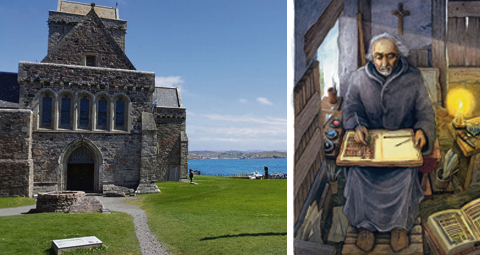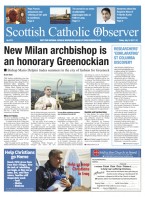July 14 | ![]() 0 COMMENTS
0 COMMENTS ![]() print
print

Researchers’ ‘exhilarating’ St Columba discovery
Archaeologists have uncovered remarkable new evidence about St Columba’s sixth century life on Iona.
Carbon dating has led to the significant breakthrough, which categorically proves a hut long associated with the saint dates back to the exact period Columba lived and worked at the Inner Hebridean monastery and may well be the monk’s ‘cell’ where he prayed and studied in isolation.
Bishop Brian McGee of Argyll and the Isles said it was a ‘very interesting discovery’ that underlined ‘just how important the legacy of St Coloumba is.’
St Columba, known in Gaelic as Colum Cille, ‘the dove of the Church,’ is one of the key figures that brought Christianity to Scotland from Ireland, landing on Iona in AD563.
Life of St Columba, written 100 years after the saint’s death by his successor Adomnán, described St Columba writing in his cell on a rocky hillock, called Tòrr an Aba or ‘the mound of the abbot,’ within the monastery looking out his door towards the mountains of Mull. The new carbon testing suggests archeologists may now have samples of that very hut.
The samples from the hut where uncovered in the 1960s but were believed to be missing, until a Historic Environment Scotland-funded project led by University of Glasgow archaeologists Ewan Campbell and Adrián Maldonado, relocated the samples.
Commenting on the findings, archaeologist Adrián Maldonado said: “This discovery is massive. St Columba is a key figure in Western Christendom. He was the national patron saint of Scotland in the Middle Ages.
“This is as close as any archaeologist has come to excavating a structure built during the time of St Columba.
“It is a remarkable lesson in the value of curating excavation archives for as long as it takes, to make sure the material is ready for the next wave of technology.”
Professor Thomas Clancy, Celtic and Gaelic historian at the University of Glasgow, said: “The results of the radiocarbon dating are nothing short of exhilarating. The remains on top of Tòrr an Aba had been dismissed as from a much later date. Now we know they belonged to a structure that stood there in Columba’s lifetime.
“More than that, the dates, and our new understanding of the turning of the site into a monument not long after its use, makes it pretty clear that this was St Columba’s day or writing house. From here, he oversaw the day-to-day activities of his monastery.
“Even more exciting, we may even have a manuscript written in Columba’s ‘little house.’
“The ‘Cathach,’ a manuscript of the psalms, long been reputed to be Columba’s own writing and which is certainly one of our earliest manuscripts from this part of the world dating to Columba’s time, was certainly written on Iona.
“If Columba indeed wrote it, and I see no good reason why he shouldn’t have, it was likely in the ‘little house’ whose remains have now been pinned to Columba’s own lifetime.”
Bishop McGee said that St Columba was not the first, or the most famous, of the early saints who took Christianity from Ireland to Scotland but he could be the most significant.
“He came to Iona seeking Christ, he then helped his community to seek Christ and they then moved out all across the country, with that Faith and great learning and brought Christianity to so many people,” he said.
“His immediate legacy was the great Abbey at Iona becoming a hub of civilisation for people all over Europe, but his greater legacy is how he brought the Faith to so many and continues to inspire so many. I pray to him every morning.”
The bishop added that is was ‘wonderful’ that the Catholic house of prayer is active on Iona so that once again people can pray and celebrate the Mass on Iona as St Columba did.”











